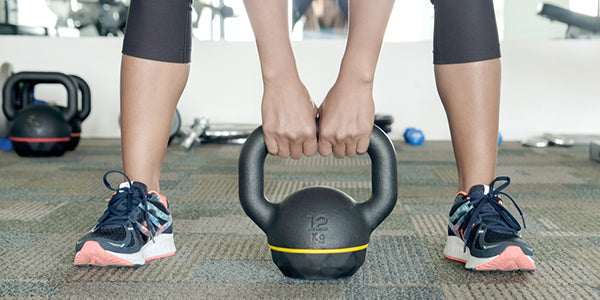
While it is worthwhile to exercise, exercise should ultimately be worth your while. And after not reaping benefits of putting time in the gym, you may just want to throw in the towel altogether.
But rather than sweating the disappointment, gain control and strength by learning how to start weight training in safely, yet effectively.
Strength training and exercise has a number of benefits even beyond losing weight. These include, but are not limited to, enhanced bone strength and greater independence.
1. Accelerated Metabolism
From exercise to simply breathing, metabolism encompasses the energy needed to accomplish all body processes. Metabolism is ongoing and continues even when the body is at rest, more formally known as resting metabolic rate (RMR).
Body composition, or muscle versus fat, mostly determines the rate at which energy is produced. That being said, gaining muscle mass and reducing body fat ultimately accelerates metabolism and burns more calories. This serves true even when the body is at rest.
2. Increased Muscle Strength
People often start lifting weights to promote muscle growth and strength. Maintaining and increasing strength helps reduce day-to-day injuries, especially if lifting objects.
Strength training also staves from muscle wasting and weakening that often comes with age. This can help people maintain independence and fall risk.
3. Enhanced Bone Strength
Weight-bearing exercises support bone density, thus lowering the risk of bone fractures and osteoporosis. This is extremely valuable for aging adults, especially women, as they are generally more at risk for bone weakening.
Strength training can also improve pain linked to osteoarthritis, a joint disease occurring when connecting tissue between bones wears down.
4. Fostered Body Mechanics
Safe and structured muscle movements offer body stabilization. Targeting all muscle groups can be really beneficial to posture and poise.
Optimized functional movements helps improve activities of daily living (ADLs) as well.
5. Improved Mental Health
Not only will you stand tall with improved posture, but exercise further stimulates those "feel good" hormones known as endorphins.
Improved mood and confidence can ultimately contribute to an improved quality of life.
Wanting to start a strength training workout but not sure where to begin? Learn how to lift weights and train the right way with these expert tips.
1. Check with a Doctor
Consult with a doctor before jumping into an exercise program, especially if managing a health condition.
Their expertise can establish a safe starting point to prevent injury, all while considering your needs and workout goals.
2. Start Slow and Steady
Lifting heavy and reaping the benefits of a stronger physique is desirable and ambitious. However, it is important to do so in a slow and steady manner.
Overdoing it with heavy weights and too many repetitions may actually just cause injury, potentially pushing back your goals.
3. Focus on Form
Rather than uncomfortably trying to lift heavy weights, focus primarily on correct form. Because remember, weight can always be added and technique is always more important than strength.
Learning the proper techniques and range of motions can facilitate better results and lessen the likelihood of injury. If new to resistance training, body weight exercise and stationary machines are helpful. Include free weights and approach barbells once technique, comfort, and strength start to grow.
4. Lift an Appropriate Weight Amount
Especially if researching how to lift weights for beginners, you may be wondering, "How much should I be lifting?" There really is no direct answer, as people have varying strengths and abilities, but rather an informal recommendation and strategy.
Weights should feel heavy, but bearable, and start to make muscles feel fatigued after 12 repetitions. Most weight training programs advocate for achieving between 10 to 15 repetitions for three to four sets or rounds. For example, squatting with five pounds for three sets of 12 reps.
5. Offer Balance
While bulking up the biceps may be your primary goal, all major muscle groups should be targeted. This includes muscles of the lower and upper body such as the chest, back, core, legs, and arms.
For example, instead of always working on a bench press, include back exercises as well.
6. Partner Up
Working out with a lifting partner can be helpful in the gym for a number of reasons.
First off, a partner can be a motivator to get you to the gym! Acting as a spotter, they can help reduce and prevent the risk of weight training injuries.
7. Stretch
Stretching may be one of the most underrated components of physical activity. However, it is important to stretch directly following a workout when the muscles are still "warm" and loose.
Continuous light movement throughout the day can also prevent muscles from feeling stiff and tightening up.
8. Allow Rest
Fighting against "There is no rest for the wicked," rest is a necessary component of weight training. The body does need time to recover and repair itself, especially if movements are new.
Really, more does not always mean better and resting is sometimes the best "exercise" for the body. Allow it to heal and recover between workouts and targeted muscle groups. It is also critical to not push through severe pain, as doing so may cause severe injury.
9. Combine with Cardio Workouts
Health experts and exercise advocates generally agree on a couple of concepts:
1) Some exercise is better than no exercise and 2) Aerobic exercise and strength training complement one another.
So in addition to resistance training, include cardio in a workout program for maximum full body benefit. Aerobic exercise can be completed at home, outside, in the gym, and, well, virtually anywhere.
Cardio exercises include brisk walking, jogging, cycling, swimming, and any other continuous movements that elevate heart rate.
10. Nourish the Body with Pre and Post-Workout Meals
Since exercise and diet go hand-in-hand, fueling and nourishing the body should not go unnoticed.
Especially when weight training, adequate protein stimulates muscle repair and growth. Healthful carbs replete glycogen stores and stabilize blood sugars as well.
Also, aim to drink at least 64-ounces of water each day to reduce the risks of dehydration and muscle cramps.






